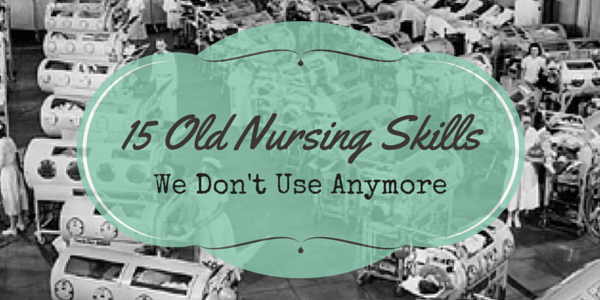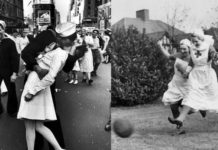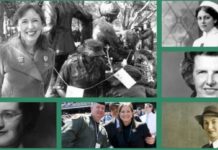Nursing is a dynamic and evolving profession, and there are old nursing practices we used to do that have been rendered obsolete. As research studies advance and prove certain patient care routines are actually not as effective, the medical field updates and replaces these skills to ensure quality nursing care.
Let us take a trip down the memory lane and look back at old nursing skills nurses don’t use anymore:
1. Flushing saline solution during tracheal suctioning
Years before, it was a routine practice to flush saline solution into the endotracheal tube during tracheal suctioning. It helped in loosening dried mucous plugs around the endotracheal tube.
However, studies have shown that this practice increases the risk of pneumonia. Bacterial growth around the endotracheal tube is introduced deeper into the lungs when saline solution is flushed into the tube.
2. Bathing febrile children with alcohol
Before, pediatric patients with fever routinely received sponge baths with a solution of lukewarm water and alcohol. It was believed that alcohol helped in lowering body temperature faster.
However, advancements in pediatric care voided the continuity of this practice. It was proven that tepid sponge bath with water alone is more effective in lowering down fever. Adding diluted alcohol may further cause skin irritation as alcohol increases friction heat when rubbed into the skin.

Also Read: 25 Life Hacks Every Nurse Should Know
3. Resterilizing urinary catheters and syringes
Different disposable medical equipments we use nowadays were made to be reusable decades ago. Nurses had to re-sterilize these equipments after each use. They were made from glass and re-sterilization required boiling or autoclaving.
Since the emergence of HIV in the 1980s, healthcare institutions were encouraged to use disposable urinary catheters and syringes. Re-sterilizing them proved to be a more costly process for hospitals hence, most institutions shifted to disposable single-use medical equipments.

4. Use of the Iron Lung Machine
The iron lung machine is a negative pressure ventilator. It was used for patients who have lost normal muscle control for breathing. Used a lot on polio patients, it controlled intrapulmonary pressure by encasing a patient’s thoracic part inside an air-sealed pressure- controlled chamber.

Since the practice of positive pressure ventilator through endotracheal intubation emerged, iron lung machines have slowly disappeared. Nowadays, only a handful of functional iron lung machines are still in use in the US and few nurses know how to operate them.

Also Read: 50 Vintage Photos of Nurses Being Awesome
5. Administering soap-sud enemas for constipation
Administering soap-sud enemas for constipation was a common practice years before. There were only a few laxative preparations available during that time so enemas were usually ordered for constipation.
However, researches showed that soap-sud enemas may have adverse effects to the intestines since soap is an irritant. This old practice has been eradicated as more laxative preparations emerged in the pharmaceutical industry.

6. Use of rotating tourniquets
The practice of using rotating tourniquets was used before for the management of pulmonary edema secondary to left heart failure. The purpose of this practice was to pool blood in the extremities to decrease cardiac load.
Nurses were using this skill decades ago but with the development of more potent cardiac drugs for pulmonary edema, this practice is no longer recommended. It’s a time-consuming task backed up with few studies if really effective or not.

7. Shaking mercurial thermometers
Mercurial thermometers made out of glass were the standard thermometers before digital thermometers emerged. They were soaked in containers filled with alcohol and cotton.
Mercurial thermometers need to be shaken hard to lower the mercurial line up to a certain point. Back in those days, nurses constantly shaking thermometers were the usual scenes in the ward.

8. Narrative charting with color-coded inks
Before the advent of computers, nurses documented the nursing care they rendered through tri-color charting. Different colors of ink were used depending on the shift of duty. Black ink was used for day shift, green ink was for afternoon shift and red ink was for night shift.
During those times, nurses piled up charts at the end of the shift so they could finish their narrative chartings. Nowadays, charting and record of patient care is made easier with the newest computers and gadgets.

9. Shave preps before surgery
Before, preoperative preparations for surgery patients included shaving. Studies have shown that shaving increases the risk of surgical site infection after the surgery so this practice is not recommended anymore.
Instead of shaving, hair clipping is now recommended for skin preparations before surgery.

10. Milking chest tubes
Milking the chest tubes of patients with thoracotomy bottles is one of the well-known old nursing practices. Usually, the physician ordered milking of chest tubes every end of shift. Nurses also milked test tubes whenever hardened secretions visibly obstructed the tube.
This practice is not recommended anymore though since it poses risk for air leakage within the chest tube. It also causes tissue irritation and trauma.
11. Getting blood pressure reading through palpation
Back in the days when hospitals were still using mercurial BP apps, nurses could get blood pressure readings without using a stethoscope. This is possible through palpation where you will feel when the loudest beat will occur as you inflate the cuff.
Nowadays, digital BP apps can instantly obtain blood pressure reading which saves time for most nurses. However, getting blood pressure reading through palpation is still practiced during emergency situations especially when the patient is hypotensive.

12. Manual regulation of IV fluids
Decades ago, IV fluids were manually regulated as infusion pumps were not yet invented during that time. Nurses manually counted and calculated IV drip rates of each patient.
Currently, the use of infusion pumps make IV fluid regulation easier for nurses. Some large preparations of IV medication are also easier to regulate with the help of syringe pumps.
Also Read: 35 IV Therapy Tips & Tricks for Nurses
13. Use of Dakin’s Solution for wounds
Dakin’s solution is composed of sodium hypochlorite and baking soda. It was first used during World War I to treat severely infected wounds. It was invented by Henry Drysdale Dakin, an English chemist and Alexis Carrel, a surgeon. After the war, this wound antiseptic was frequently used for bed sores and infected surgical wounds.
Nowadays, nurses rarely prepare Dakin’s solution as more topical antiseptic medications have became available especially for infected surgical wounds.

14. Use of Trilene/Penthrane inhalers for labor pain
Trilene/Penthrane inhalers were widely used in the 1960s especially among obstetric patients undergoing labor pain. It was frequently used as a PRN medication whenever the patient could not stand the pain of labor.
This practice was later discontinued as patients may accidentally inhale too much trilene/penthrane which can further cause adverse effects to the unborn baby.
15. Doing sliding scale insulin with urine dipstick results
Before the emergence of glucometer devices, sliding scale insulin depended on urine dipstick results. Nurses obtained a patient’s urine sample before meals to test for the presence of glucose.
When glucometer devices became available, relying on urine dipstick results was no longer recommended. Urine dipstick tests can produce inaccurate results as there are some people that normally excrete glucose in the urine even if they don’t have diabetes. Patients also have a higher chance of manipulating the results by diluting their urine samples.
Do you know more old nursing practices that are not used anymore? It’s fun to reminisce the times when these outdated practices are still valid for patient care. Let us know in our FB page if you know more outdated patient care practices from your work.



















